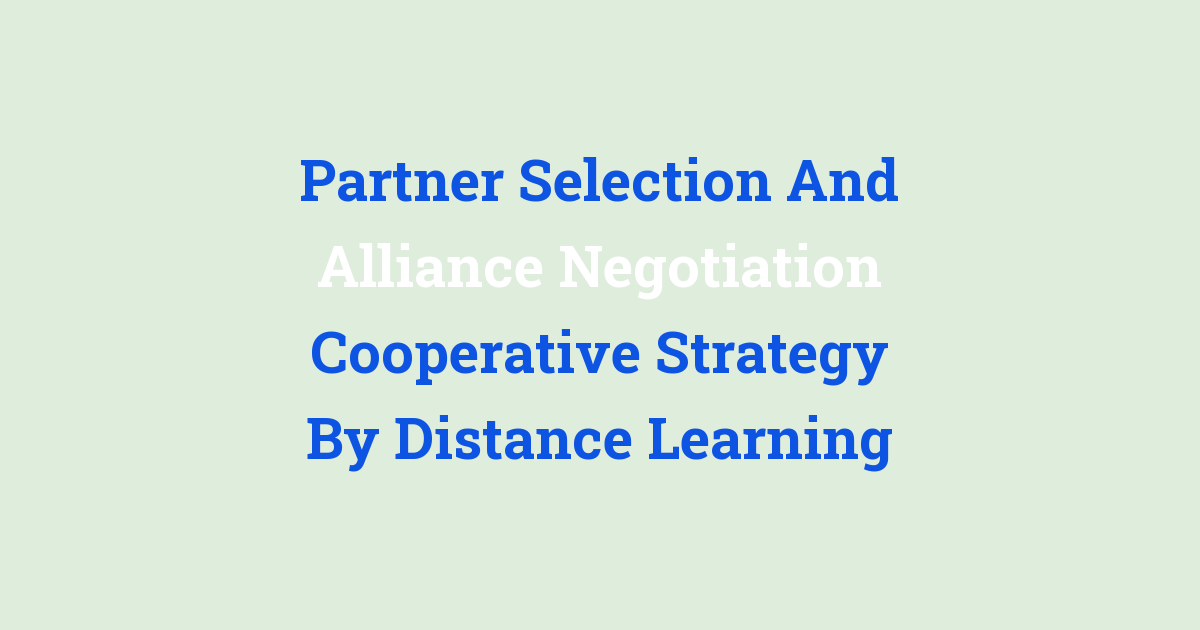Cooperative strategy through distance learning for partner selection and alliance negotiation.
Partner Selection and Alliance Negotiation Cooperative Strategy by Distance Learning
Introduction
In today’s fast-paced and highly competitive business environment, companies are increasingly turning to strategic alliances to gain a competitive edge. These alliances allow companies to leverage each other’s strengths and resources in order to achieve mutual goals. However, the success of these strategic alliances hinges on the careful selection of the right partners and the negotiation of mutually beneficial agreements. In this report, we will explore the process of partner selection and alliance negotiation through distance learning, focusing on the advantages and features of this cooperative strategy.
Problem Statement
The traditional approach to partner selection and alliance negotiation involves face-to-face meetings and negotiations, which can be time-consuming and costly. This can also limit the pool of potential partners, as companies are often restricted by geographical boundaries. In addition, the lack of expertise in selecting the right partners and negotiating favorable agreements can lead to failed alliances and wasted resources. Therefore, there is a need for a more efficient and effective way to engage in partner selection and alliance negotiation.
Existing System
The existing system of partner selection and alliance negotiation relies heavily on personal interactions and physical meetings. Companies typically rely on their existing networks and personal connections to identify potential partners. Once identified, face-to-face meetings are arranged to discuss the terms of the alliance and negotiate an agreement. This process can be time-consuming and costly, as it often requires travel and accommodation expenses. Additionally, the lack of expertise in negotiation techniques can result in suboptimal agreements.
Disadvantages
There are several disadvantages to the existing system of partner selection and alliance negotiation. Firstly, the reliance on personal networks can limit the pool of potential partners, as companies may not be aware of all possible options. Secondly, the time and cost involved in face-to-face meetings can be prohibitive, particularly for small and medium-sized enterprises. Finally, the lack of negotiation expertise can lead to one-sided agreements that do not fully benefit both parties.
Proposed System
The proposed system of partner selection and alliance negotiation involves leveraging distance learning technologies to facilitate the process. Companies can use online platforms to identify potential partners from a wider pool of candidates. This can include companies from different geographical locations, industries, and sizes. Once potential partners are identified, negotiations can be conducted through virtual meetings, webinars, and video conferencing. This allows for more efficient and cost-effective negotiations, as travel expenses are minimized.
Advantages
There are several advantages to the proposed system of partner selection and alliance negotiation. Firstly, companies can access a wider pool of potential partners, increasing the likelihood of finding the right fit. Secondly, the use of distance learning technologies reduces the time and cost involved in negotiations, making it more accessible to companies of all sizes. Finally, the virtual nature of the negotiations can lead to more objective and strategic decision-making, as emotions and personal biases are minimized.
Features
The key features of the proposed system include online partner selection platforms, virtual negotiation tools, and expert guidance. Online partner selection platforms use algorithms and data analysis to match companies based on their strengths, weaknesses, and objectives. Virtual negotiation tools include video conferencing, document sharing, and real-time messaging, allowing for seamless communication and collaboration. Expert guidance can be provided through online courses, webinars, and consulting services, helping companies navigate the complexities of partner selection and negotiation.
Conclusion
In conclusion, the process of partner selection and alliance negotiation is crucial for the success of strategic alliances. By leveraging distance learning technologies, companies can access a wider pool of potential partners, reduce the time and cost of negotiations, and make more informed decisions. The proposed system offers a more efficient and effective way to engage in partner selection and alliance negotiation, ultimately leading to stronger and more successful alliances.

